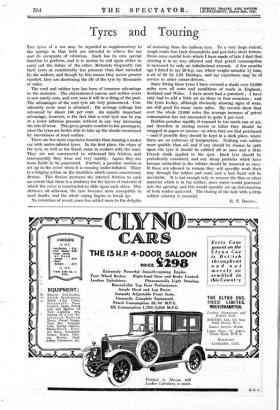Tyres and Touring
Tim tyres of a car may be regarded as supplementary to the springs in that both are intended to relieve the car and its occupants of vibration. Each has its own special function to perform, and it is unwise to call upon either to carry out the duties of the other. Motorists frequently run their tyres at considerably less pressure than that intended by the makers, and though by this means they secure greater comfort, they are shortening the life of the tyre by thousands of miles.
The cord and rubber tyre has been of immense advantage to the motorist. The, old-fashioned- canvas and rubber cover is now rarely seen, and very soon it will be a thing of the past. The, advantages of the cord tyre are very Pronounced. Con- siderably more wear is obtained ; the average mileage has advanced by about 100 per cent. An equally important advantage, however, is the fact that a cord tyre can be run at a lower inflation pressure without in any way increasing the rate of wear. This gives greater comfort to the passengers, since the tyres are better able to take up the shocks occasioned by unevenness of road surface.
There are few-more expensive luxuries than running a motor car with under-inflated tyres. In the first place, the edges of the tyre, as well as the tread, come in contact with the road. They are not constructed to withstand this friction, and consequently they wear out very rapidly. Again, they are more liable to be punctured. Further, a peculiar motion is set up in the cover when it is running under-inflated. There is a hinging action on the shoulders which causes unnecessary flexion. This flexion increases the internal friction to such an extent that there is a. tendency for the layers of material of which the cover is constructed to slide 'upon each other. This destroys all adhesion; the tyre becomes more susceptible to road shocks, and the whole casing begins to break up.
No invention of recent years has added more to the delights
of motoring than the balloon tyre. To a very large extent, rough roads lose their discomforts and pot-holes their terrors. From some careful tests *bleb I have made of late I find that steering is in no way affected and that petrol consumption is increased by only an infinitesimal amount. A few months ago I fitted to my 20-h.p. car, which weighs' unladen 14 tons, a set of 32 by 5.25 Dunlops, and my experience- may be of service to other owner-drivers.
Since fitting these tyres I hale covered a shade over 12,000 miles over all sorts and conditions of roads in England, Scotland and Wales. I have never had a puncture ; I have only had to add a little air on three or four occasions ; and the tyres to-day, although obviously showing signs of wear, are still good for many more miles. My records show that over the whole 12,000 miles the average increase of petrol consumption has not amounted to quite 2 per cent.
Rubber perishes rapidly if exposed to too much sun or air, and therefore in storing covers or tubes they should be wrapped in paper or canvas—as when they are first purchased —and if possible they should be kept in a dark place, where there are no extremes of temperature. Nothing rots rubber more quickly than oil, and if any should by chance be spilt upon the tyre it should be rubbed off at once and a little French chalk applied to the spot. Each tyre should be periodically examined, and any sharp particles which have become embedded in the rubber should be removed at once. If these are allowed to remain they will speedily work their way through the rubber and cord, and a bad burst will be inevitable. It is not enough only to remove the flint or other material which is in the rubber, since water would penetrate into the opening, and this would speedily set up deterioration of both rubber and cord. The closing of the hole with-a little rubber solution is essential.
E. T. BROWN.


























































 Previous page
Previous page